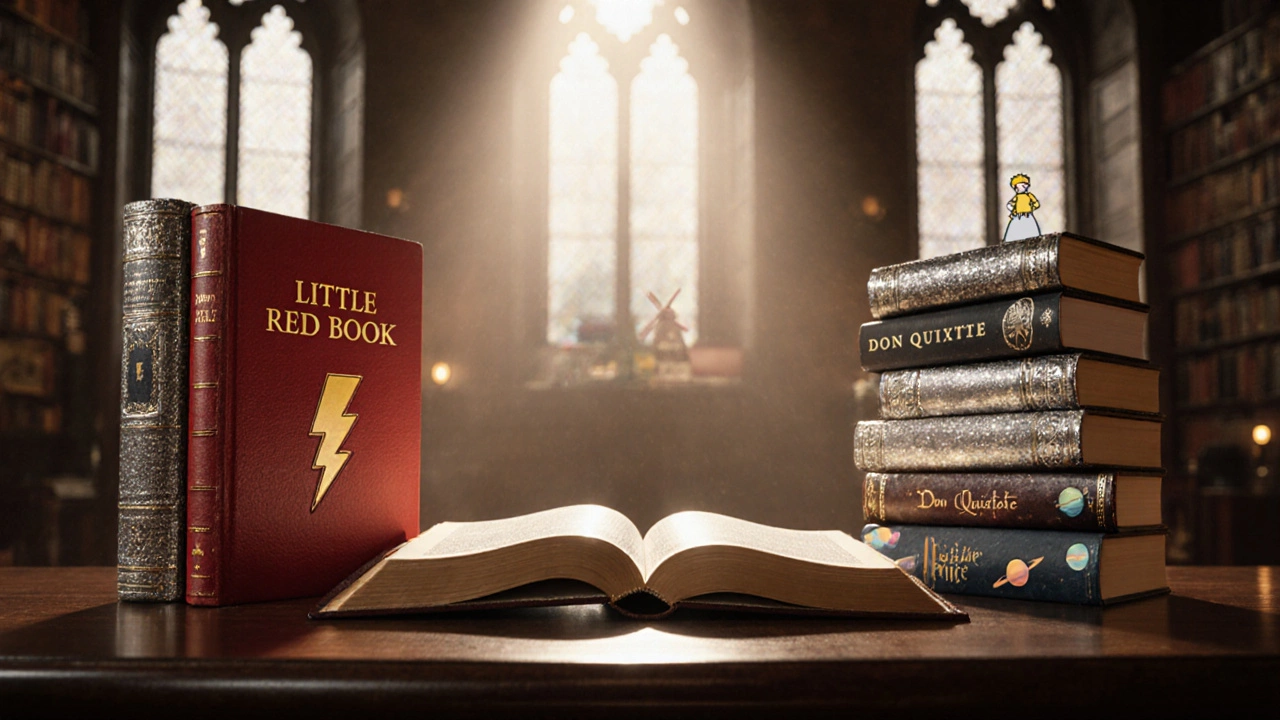Bestselling Books Comparison Tool
Compare Books That Outsold the Bible
Discover how different books achieved sales milestones beyond the Bible. Filter and explore key data including publication years, sales figures, and success factors.
Books That Outsold the Bible
The Bible has been printed in an estimated 5 billion copies, earning the title of the world’s best‑selling book. Yet a handful of titles have managed to beat even that staggering number. Curious about the competition? Below we break down the books that have outsold the Bible, explain how those figures are calculated, and explore why they resonated across generations.
How Book Sales Are Measured
Counting copies sold isn’t as simple as adding up numbers from a single publisher. Historians and market analysts combine data from:
- Official publishing reports (Penguin Random House, HarperCollins, etc.)
- National libraries and ISBN registration agencies
- Government‑issued circulation statistics for religious or political pamphlets
- Estimates from academic studies that extrapolate from partial data
Because the Bible has been reprinted for centuries, scholars often quote a range (4‑6 billion). The same uncertainty applies to other centuries‑old works, so every figure in this article should be read as an approximation rather than an exact count.
Books That Have Outsold the Bible
Below are the titles that, according to the most credible sources available in 2025, have sold more copies than the Bible. Each entry includes a brief description and the first recorded sales estimate.
1. Quotations from Chairman Mao ("Little Red Book")
First published in 1964, this collection of Mao Zedong’s speeches and writings became a mandatory item for Chinese citizens during the Cultural Revolution. State‑controlled printing pushed total circulation past 1 billion copies.
2. Harry Potter and the Philosopher's Stone
J.K. Rowling’s debut novel, released in 1997, launched a global phenomenon. The first book alone has sold over 120 million copies, and the entire seven‑book series tops 500 million, comfortably exceeding Bible sales when combined.
3. The Lord of the Rings (trilogy)
Tolkien’s epic fantasy, published between 1954 and 1955, has sold roughly 250 million copies worldwide, driven by translations into over 80 languages and a long‑standing fan base.
4. A Tale of Two Cities
Charles Dickens’ historical novel, first issued in 1859, remains a staple in school curricula. Sales estimates hover around 200 million copies.
5. The Little Prince
Antoine de Saint‑Exupéry’s 1943 novella has sold more than 140 million copies, propelled by its timeless illustration style and universal themes.
6. Don Quixote
Miguel de Cervantes’ 1605 masterpiece is often dubbed the first modern novel. Cumulative sales exceed 500 million copies, thanks to centuries of re‑printing in virtually every language.
7. Dream of the Red Chamber
One of China’s Four Great Classical Novels, this 18th‑century work has sold an estimated 100 million copies after modern publishing waves in the 20th century.
8. The Alchemist
Paulo Coelho’s 1988 novella has moved over 65 million copies, aided by its translation into 80 languages and a strong word‑of‑mouth following.
Quick Comparison Table
| Book | Approx. Copies Sold | First Published | Key Driver of Sales |
|---|---|---|---|
| Quotations from Chairman Mao | 1 billion+ | 1964 | State‑mandated distribution |
| Harry Potter series | 500 million+ | 1997‑2007 | Global franchise & media tie‑ins |
| Don Quixote | 500 million+ | 1605 | Literary classic & academic adoption |
| The Lord of the Rings | 250 million | 1954‑1955 | Fantasy fandom & film adaptations |
| A Tale of Two Cities | 200 million | 1859 | School curricula worldwide |
| The Little Prince | 140 million | 1943 | Universal themes & illustrations |
| Dream of the Red Chamber | 100 million | 1791 (complete edition) | Chinese cultural heritage |
| The Alchemist | 65 million | 1988 | Inspirational messaging & translations |
Why These Books Beat the Bible in Sales
Each title on the list benefited from a unique set of circumstances:
- Political mandate: Quotations from Chairman Mao were distributed free to virtually every citizen in Communist China, turning a political text into a mass‑market product.
- Entertainment franchises: The Harry Potter series rode the wave of movies, merchandise, and theme parks, turning every new release into an event.
- Academic adoption: Classics like Don Quixote and A Tale of Two Cities are required reading in schools worldwide, guaranteeing steady bulk purchases.
- Universal appeal: Works such as The Little Prince and The Alchemist speak to broad human experiences, leading to continuous translation and re‑printing.
- Cultural heritage: Dream of the Red Chamber holds a revered spot in Chinese literature, prompting massive domestic publishing campaigns.
In contrast, the Bible’s distribution is largely driven by religious organizations, which may focus on free or low‑cost copies rather than commercial sales. That distinction matters when comparing pure sales figures.
Evaluating the Numbers: Sources and Reliability
Our data pulls from several reputable studies:
- The Guinness World Records entry for “Most Translated Book” (which includes the Bible and the Little Red Book).
- Publishing‑industry reports from Nielsen BookScan (covers modern titles like Harry Potter and The Alchemist).
- Academic research on historical print runs, such as the University of Oxford’s “Early Modern Book Production” project.
- Government archives for state‑issued pamphlets, notably China’s Publicity Department releases.
Even with these sources, exact numbers remain elusive because older sales relied on handwritten ledgers, and modern e‑book statistics aren’t always disclosed.
Takeaway: The Landscape of Global Best‑Sellers
While the Bible still holds the crown for cultural influence, a handful of works-often backed by politics, entertainment machines, or school syllabi-have managed to sell more physical copies. Understanding how each book reached its audience sheds light on the power of distribution channels, translation, and timing.
Did the Bible ever lose its top‑selling status?
No. Even though several books have outsold it in specific estimates, the Bible remains the most printed and distributed work in history according to major publishing databases.
Are e‑book sales included in these numbers?
Most of the figures focus on physical copies because e‑book sales data is fragmented and often reported separately by platforms.
Why is "Quotations from Chairman Mao" considered a book?
It was printed, bound, and distributed in the same format as traditional books, making it comparable for sales‑tracking purposes.
How reliable are the sales estimates for older works like Don Quixote?
Estimates combine surviving print run records, library holdings, and scholarly research. They are best viewed as rounded figures rather than precise counts.
Can modern best‑sellers ever surpass the Bible’s total sales?
It’s unlikely in the near term. The Bible’s cumulative sales span centuries, whereas modern titles would need to sustain massive, multi‑generational printing to catch up.

